Battlefield 6 marks the first time, in all my years of hardwaring, that I have been summoned to someone’s house in order to make a PC game work. I can’t offer this Jim’ll Fix It service to everyone, not least because IGN’s lawyers have issues with the name, so I’ll just say this: Enabling Secure Boot and TPM 2.0 is inconvenient, but not as fiddly as it sounds, and can be done with at most a couple of toggles in your BIOS/UEFI’s Security section.
As it turns out, that’s probably the worst of BF6’s hardware worries. I don’t know who forgot to tell DICE that all FPS blockbusters must now be callously demanding graphics card shin-kickers, but in both the campaign and multiplayer, this seems to run quite… well? Likely well enough that as long as you’re on any reasonably modern rig, you might not need to do much twiddling with the visual settings.
Still. Let’s have a go at it anyway.
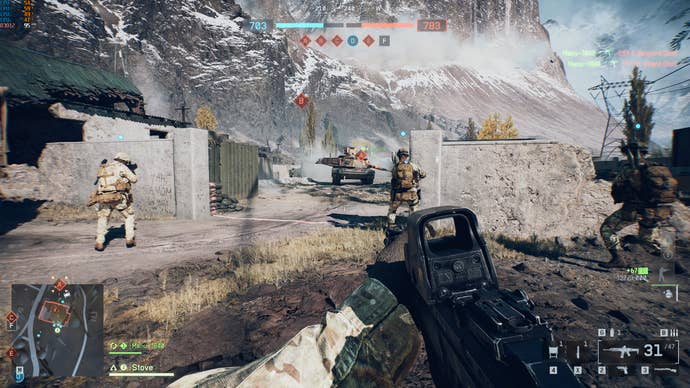
Battlefield 6 system requirements and PC performance
For a game that ultimately performs rather smoothly, BF6 does exhibit some oddities in its PC requirements. There’s the TPM and Secure Boot requirement, of course, which I suspect adds the need for a newer generation of CPUs than the game might have required otherwise. It’s rare to see two different install sizes between the minimum and recommended specs, too – EA say this is owing to how the highest-res textures are an optional download. I wasn’t offered this option when downloading through Steam, the luxury textures being bundled in by default, but then it could be added in the planned day-one patch.
Battlefield 6 minimum PC specs
- OS: Windows 10
- CPU: Intel Core i5-8400 / AMD Ryzen 5 2600
- RAM: 16GB RAM
- GPU: Nvidia GeForce RTX 2060 / AMD Radeon RX 5600 XT 6GB / Intel Arc A380
- DirectX: Version 12
- Storage: 55GB available space
- Additional Notes: TPM 2.0 Enabled, UEFI Secure Booth Enabled, HVCI Capable, VBS Capable
Battlefield 6 recommended PC specs
- OS: Windows 11
- CPU: Intel Core i7-10700 / AMD Ryzen 7 3700X
- RAM: 16GB RAM
- GPU: Nvidia RTX 3060 Ti / AMD Radeon RX 6700 XT / Intel Arc B580
- DirectX: Version 12
- Storage: 80GB available space
- Additional Notes: TPM 2.0 Enabled, UEFI Secure Booth Enabled, HVCI Capable, VBS Capable
Fortunately, nothing here is too mad, with the recommended GPUs in particular comprised of older mid-range cards and newer budget models. After finding a good benchmarking spot – a highly explosion-ridden, destruction-heavy armoured attack sequence early in the campaign – I tried the Overkill preset on the Arc B580, which at its natural 1080p resolution, averaged a comfortable 68fps. While Intel’s GPU had the advantage of pairing with the RPS Test Rig’s very much above-spec Ryzen 7 9800X3D, that’s inarguably a good result for a cheap card running non-upscaled max settings.
Even the underpowered RTX 5050 had a solid go, averaging 62fps – also on Overkill – with native-res TAA, and enabling DLSS upscaling on Quality mode pushed that to a slick 79fps. BF6’s DLSS 4 support also let it switch on 4x Multi Frame Generation (MFG) for 185fps, and although most of those weren’t real frames, everything looked smooth and clean in motion. Input lag – frame generation’s ancient enemy – didn’t spike too high either, making MFG a viable option, so long as there’s a strong base of conventional frames to build on.
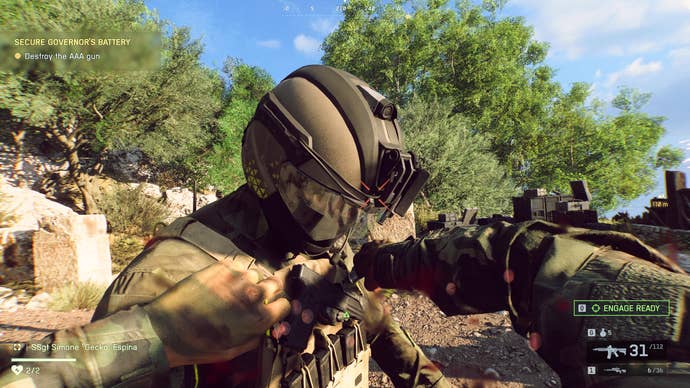
Plenty of other affordable cards make the grade too. Without DLSS, the RTX 4060 managed 64fps at 1080p/Overkill, rising to 73fps on the less VRAM-intensive Ultra. The 8GB version of the RTX 4060 Ti only went slightly faster, averaging 67fps at 1080p, but with DLSS on Quality it could still hit 63fps at 1440p. Heading up a couple of GeForce tiers, Quality DLSS paved the way for the RTX 4070 Ti to produce 114fps at 1440p – or 174fps with 2x frame gen – and the same settings were more than playable at 4K, averaging 107fps with frame gen and 73fps without.
Battlefield 6 also scales well with the latest and greatest hardware, with the RTX 5080 pumping out 102fps at 4K/Overkill with just a touch of Quality DLSS. 4x MFG pushed this to up to 277fps, with aiming still feeling sharp, though if you don’t have a 240Hz-plus monitor then it makes more sense to stick with 2x or 3x. Otherwise, you’re just spending resources to generate frames you can’t see.
I’ve been saying “averaged” so much because there can be framerate peaks and troughs, depending on what’s happening on-screen: the same PC might render a hectic firefight around 80fps and a quiet sneak through a hallway at 100fps. But in practice, these oscillations aren’t so sudden as to be particularly noticeable, and I never witnessed any bothersome stuttering, even when I was wilfully disregarding the game’s warnings about graphics memory shortages.
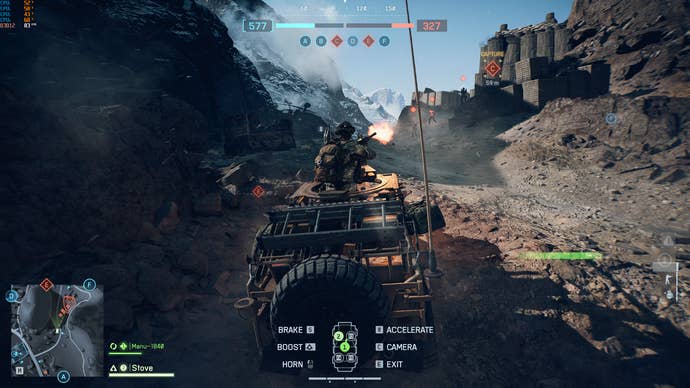
What the hell, Battlefield 6? You’re an action game in 2025. Aren’t you supposed to be sluggish and forcibly ray traced, or what. It’ll even run on a base-model Asus ROG Ally, albeit needing the resolution dropped to 1280×720 and FSR upscaling on Quality mode to keep Low quality reliably above 30fps. Still, that’s better than on the Steam Deck, whose Secure Boot incompatibility takes it out of the running.
As for Battlefield’s historical proclivity for bugs, BF6 can’t entirely help itself, but then they’re also mainly limited to minor cosmetic flubs. The ragdolls of fresh kills jerking upwards before flopping back down, for instance, or machine gun turrets sometimes popping out of existence upon destruction, instead of rolling a falling-apart animation. There’s little evidence, including from what I’ve played of the multiplayer, for the kind of major structural weaknesses that afflicted previous Battlefields.
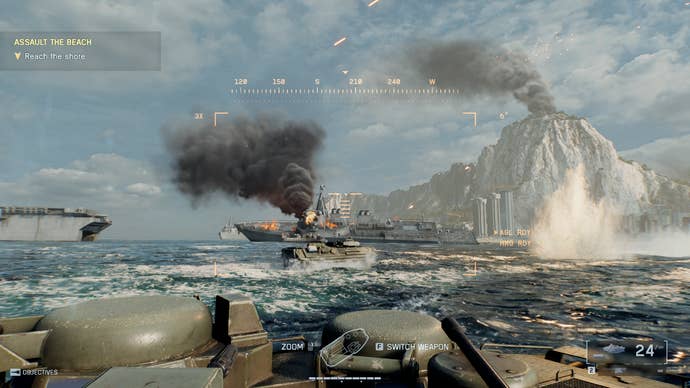
Battlefield 6 best settings guide
The gap between BF6’s highest and lowest quality settings confirms that trading shininess for speed is a feasible endeavour – which sounds obvious, yet hasn’t always been the case with recent big-budget shooters. The RTX 4060, that modest 8GB GPU that took the Overkill preset to 64fps at 1080p? That also averaged 73fps on Ultra, 84fps on High, 97fps on Medium, and 110fps on Low, so there are clearly gains to be had.
Given the better-looking settings run well on anything outside of ancient hardware and little handhelds, I wouldn’t suggest getting too chop-happy, though it’s not like Low and Medium are hideous either. In fact, certain changes – like switching anti-aliasing from the default TAA to DLSS, or disabling the murky chromatic aberration effect – can make Battlefield 6 both run and look better.
Here’s what I’ve settled on, after testing the performance impact of every individual graphics setting:
- Textures quality: Ultra
- Terrain quality: Low
- Sun shadow quality: High
- Screen space AO & GI: GTAO High
- Weapon motion blur: 0
- World motion blur: 0
- Chromatic aberration: Off
- Upscaling technique: DLSS/FSR on Quality
- Everything else: Overkill preset equivalent
Dropping from those gigabyte-devouring Overkill textures to Ultra frees up a lot of video memory usage while granting a modest FPS boost, so try it out even if you’ve got a relatively muscular rig. Terrain quality and sun shadow quality also grant small framerate bonuses, but it’s the GTAO High setting for screen space AO & GI that’s really worth choosing. Besides making the game run faster, it also produced a more stable framerate, so you’ll see less of the ups-and-downs that I mentioned earlier.
Motion blur can be enabled or disabled to taste – it doesn’t affect performance either way – but when it’s as easy to get above 60fps as it is here, it doesn’t really serve a purpose. And chromatic aberration, to my eyes, actively makes BF6 look worse, so switch it off for a clearer view.
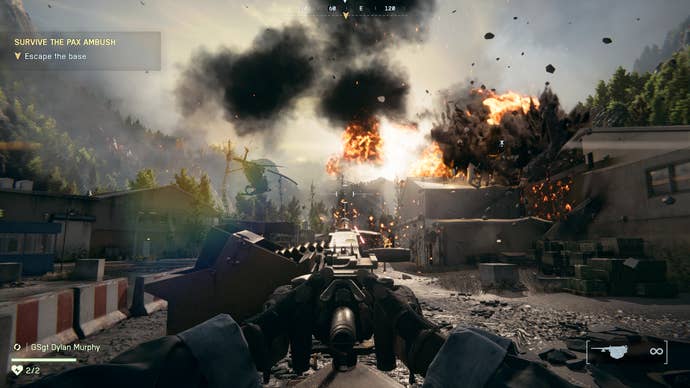
Upscaling via DLSS (or FSR, depending on your GPU) is a must as well. Not because BF6 is hopelessly slow without it – it isn’t – but because on their respective Quality modes, DLSS and FSR both look sharper than native-res TAA. Even at 1080p, where upscaling can be a diceroll on whether it looks fine or a blurry mess. Here, the blur is all TAA’s, so ditch it.
Lastly, I’ve left frame generation off the list, as it’s inherantly a cuts-both-ways kinda tech that should ways be optional, no matter what Capcom say. But with DLSS 4 in particular, Battlefield 6 does at least have one of the better implementations I’ve played with. At both 2x and 4x, it stays smooth and doesn’t drag your mouse down with excessive input lag. Just make sure you can first produce a good base framerate without it, as you probably will with the settings above; on the RTX 4060, they got that 64fps average up to 95fps, which became a responsive 143fps with 2x frame gen.







